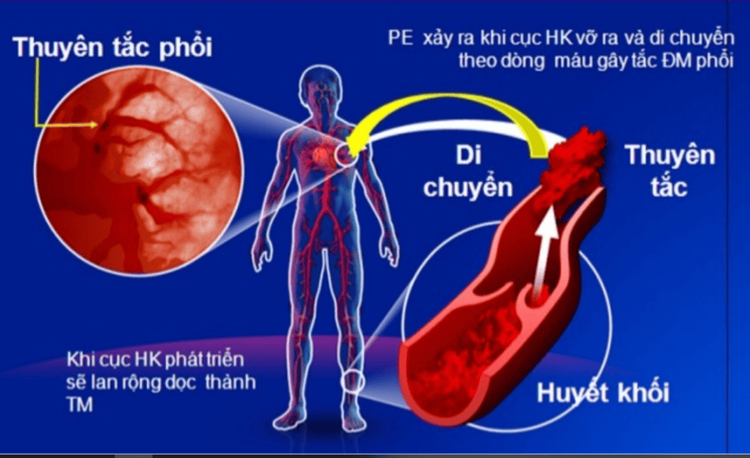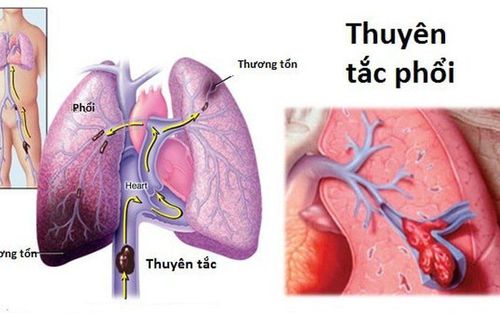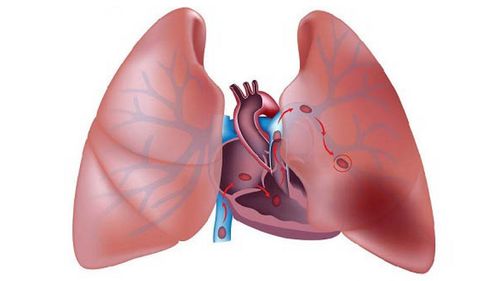This is an automatically translated article.
One of the definitive diagnostic methods used to diagnose pulmonary embolism is pulmonary scintigraphy. Pulmonary embolism or pulmonary infarction is an emergency requiring prompt treatment. Accurate and prompt diagnosis is important to help reduce the mortality rate caused by this pathology.
1. What is a lung scan?
Scanning is a method of imaging bones, organs and other parts of the body by taking a small dose of radioactive material, then when determining the amount of radioactive substance concentrated in the organ to be examined, recording is performed. In the figure, in the parts of the tissue with active vessels, there will be more gamma rays than in other parts. A recording device called a gamma camera is used to record the gamma rays emitted by the organ tissue, and then convert them into electrical signals and send them to a computer. Next, this computer will create images of different colors or density corresponding to the received signals of different intensities.
Similar to the general mechanism of scintigraphy, lung scintigraphy is performed using radioactive materials compatible with ventilation and perfusion scintigraphy. Then record images, thereby obtaining abnormal images of the lungs. In particular, this method is applied to detect pulmonary embolism, which is a medical emergency with a high mortality rate. At that time, imaging of pulmonary perfusion combined with pulmonary ventilation is essential for diagnosis, because ventilation in the area of pulmonary embolism is not obstructed in the area of obstruction, only perfusion is incapacitated.
Normally, ventilation (V) and perfusion (Q) are always compatible with each other, so when there is an incompatibility between ventilation and perfusion in the lungs, a problem is recognized in the lungs. This is the pathophysiological basis for lung scintigraphy.

Xạ hình phổi để đánh giá tình trạng tắc nghẽn động mạch phổi (thuyên tắc phổi) và tắc nghẽn thông khí phổi
2. Purpose of lung scan
Pulmonary scintigraphy is indicated when:
Evaluation of pulmonary embolism (pulmonary embolism) and obstruction of pulmonary ventilation. Especially, lung scintigraphy has high sensitivity in diagnosing pulmonary embolism. Assess the function of a certain area of the lung: It is possible to see areas of decreased or lost radioactivity, thereby identifying areas of poor lung function. Tracheal carcinoma, tuberculosis, pneumonia, lung abscess. Tracheal obstruction, tracheal dilation. Vascular narrowing or failure to develop blood vessels. Deep vein thrombosis Do the same with venous scintigraphy Assess pulmonary perfusion function after surgery. Contraindications:
Absolutely
Severe pulmonary circulatory failure, acute pneumonia. Severe pulmonary hypertension. Sensitive to proteins. Relative
Pregnant or lactating women Shunt P-T: These are malformations that cause increased pressure in the right heart cavity, causing blood to flow from the right heart to the left, causing mixing of arterial blood and static blood. Seen in the case of tetralogy of Fallot, tricuspid valve atrophy...

Xạ hình phổi chống chỉ định với phụ nữ đang có thai hoặc cho con bú
3. Steps to conduct lung scan
3.1 Preparation of radioactive substances
For ventilation scintigraphy: The radioactive substances used include xenon-133, xenon-127, krypton-81m or Tc-99m DTPA aerosol spray. Perfusion scintigraphy: Currently used, Tc-99m MAA has been substituted for the former. 3.2 Patient preparation and recording
Ventilation scan: The patient coughs, sneezes, and takes several deep breaths. Recording in the priority position of sitting position and 8 routine positions including front - back, right side - left side, right front - left front, right back - left rear. Perfusion scintigraphy: The patient lies on his back, and then the radioactive material is injected slowly into the vein. Remember to shake the radioactive material well before injecting, do not draw blood back into the syringe. After 10 minutes of injection, recording is performed, preferably in the sitting position and 8 routine positions. 3.3 Evaluation of the results
Determine the location and size of the segmental defects on the pulmonary perfusion image. Check for abnormalities on ventilation scans. The case if the lesions on the perfusion (Q) and ventilation (V) images are not matched, it may suggest a pulmonary embolism. In addition, from the image of the lung scan (V/Q) can see other medical conditions affecting ventilation such as: Tumor, abscess, inflammation, pulmonary tuberculosis...

Xạ hình phổi là phương pháp giúp chẩn đoán một số bệnh lý tại phổi
4. Some notes when doing lung scans
Normally, a lung scan does not cause any side effects, as it undergoes decay, the small amount of radioactive material in the body loses its radioactivity over time. However, when doing a scan, you may need to keep the following in mind:
Like other types of radiation, gamma rays have a small risk of affecting the fetus. Therefore, tell your doctor if you are pregnant, may be pregnant or are breast-feeding. In rare cases, a few people have had an allergic reaction to the injected medicine. Therefore, after using radioactive drugs, if you have any unusual reactions, you should immediately notify your doctor. Drink plenty of water after using radioactive material. Lung scintigraphy is a method to help diagnose some lung diseases, especially to diagnose pulmonary embolism with high sensitivity and specificity. It is very convenient and fast to perform lung scans even in emergency cases.
Vinmec International General Hospital with a system of modern facilities, medical equipment and a team of experts and doctors with many years of experience in medical examination and treatment, lung scintigraphy, patients completely You can safely examine and treat lung diseases at the Hospital.
Please dial HOTLINE for more information or register for an appointment HERE. Download MyVinmec app to make appointments faster and to manage your bookings easily.
MORE
Early signs of pulmonary embolism Risk of pulmonary embolism in pregnant and postpartum women Complications of pulmonary embolism













